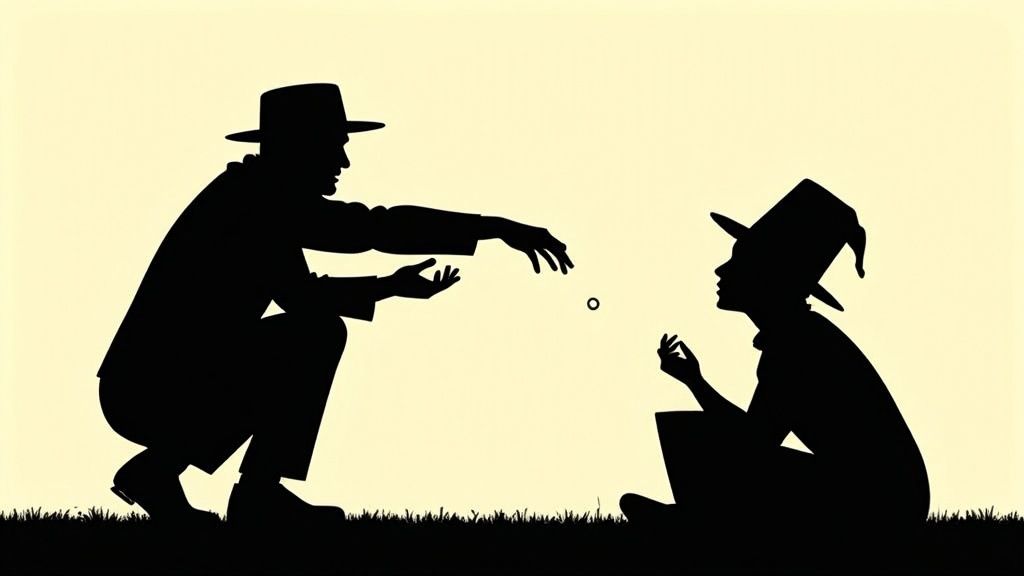- Published on
Show Don’t Tell Examples: 7 Tips to Improve Your Writing
- Authors

- Name
- Tony
- @shyeditor

Want to captivate your readers? This listicle provides seven powerful "show don't tell examples" to elevate your writing. Learn how to replace telling statements with evocative descriptions, compelling actions, and revealing dialogue. Discover techniques like sensory descriptions, character revelation through action, symbolic imagery, and environmental storytelling. Instead of simply stating emotions, learn how to show them. Mastering "show don't tell" is crucial for creating immersive experiences that resonate with readers. This article skips the theory and dives straight into practical examples covering these seven techniques: sensory descriptions, character actions, dialogue-based exposition, symbolic imagery, emotional subtext in dialogue, environmental storytelling, and cinematic scene construction.
1. Sensory Description Technique
The sensory description technique is a cornerstone of "show, don't tell" writing. It involves using vivid descriptions that engage all five senses—sight, sound, smell, taste, and touch—to create immersive reading experiences. Instead of simply stating a character's emotional state or the atmosphere of a scene, this technique paints a picture with words, allowing readers to infer meaning and connect with the story on a deeper level. This technique makes it a crucial tool for any writer looking to improve their craft. Rather than telling readers that a character is afraid, for example, a writer might describe the character's racing heartbeat, shallow breaths, and the metallic taste of fear in their mouth. This allows readers to experience the fear alongside the character, making the scene more impactful and memorable.

Consider the difference between these two descriptions: "It was cold" versus "Her breath formed clouds in the air, and she tucked her numb fingers under her armpits." The first tells the reader it's cold, but the second shows the cold through specific sensory details. This is the essence of "show, don't tell," and the sensory description technique is one of its most powerful implementations. It allows for a far richer and more compelling experience for the reader.
A prime example of this technique can be found in Ray Bradbury's Fahrenheit 451: "The autumn leaves blew over the moonlit pavement in such a way as to make the girl who was moving there seem fixed to a sliding walk, letting the motion of the wind and the leaves carry her forward." This sentence not only conveys the visual of the scene but also subtly suggests the girl's emotional state, perhaps a sense of detachment or dreaminess, through the imagery of being carried by the wind and leaves.
To effectively use the sensory description technique, focus on incorporating the following tips into your writing:
- Focus on the unexpected or specific: Instead of saying "the flowers smelled good," describe the specific scent, like "the cloying sweetness of honeysuckle mingled with the sharp tang of freshly cut grass."
- Use active verbs that convey emotion: Instead of "the wind blew," try "the wind howled" or "the wind whispered," depending on the mood you want to evoke.
- Combine multiple senses for richer scenes: Don't limit yourself to just visual descriptions. Engage as many senses as appropriate to create a more immersive experience. For instance, describe the crackling fire, the smell of woodsmoke, the warmth on the skin, and the taste of roasted marshmallows.
- Consider your viewpoint character: Which sensory details would your character be most attuned to? A chef might notice the subtle aroma of spices, while a musician might focus on the rhythm of footsteps.
The sensory description technique, popularized by writers like Ernest Hemingway (known for his iceberg theory) and Anton Chekhov ("Don't tell me the moon is shining; show me the glint of light on broken glass"), is an invaluable tool for "show, don't tell" writing. By grounding descriptions in sensory details, you can create stronger emotional connections with your readers, make your scenes more memorable, and elevate your writing to a new level.
2. Character Revelation Through Action
One of the most powerful "show, don't tell" examples is character revelation through action. This technique reveals character traits, emotions, and intentions through specific actions rather than explicit statements. Instead of telling readers someone is kind, writers show kindness through the character's decisions, behaviors, and interactions with others. This allows readers to infer character traits, creating a more engaging and immersive reading experience. This method is crucial for crafting believable and nuanced characters that resonate with readers.

This approach demonstrates personality traits through specific choices and shows character development through changing actions. Rather than labeling a character as "brave," a writer might show them facing their fears head-on, or initially hesitant but growing in courage over time. This creates more nuanced and three-dimensional characters, avoiding the trap of telling readers what to think and instead allowing them to form their own judgments. This active participation in the character development process makes the experience more memorable and impactful.
Let's look at some "show, don't tell" examples to illustrate this principle. Instead of writing, "John was generous," a more effective approach would be to write, "John gave the homeless man his last twenty dollars and walked home in the rain." This simple action speaks volumes about John's character without resorting to adjectives. Another excellent example comes from J.K. Rowling's Harry Potter: "Harry had taken one step toward it when a slithering sound made him freeze where he stood. A bush on the edge of the clearing quivered... Then, out of the shadows, a hooded figure came crawling across the ground like some stalking beast." Rowling masterfully builds suspense and reveals Harry's cautious nature through his physical reaction to the sound, rather than simply stating, "Harry was cautious."
To effectively utilize this technique, consider the following tips:
- Consider what specific actions would authentically reveal key character traits: If you want to show a character's determination, depict them overcoming obstacles instead of stating they are determined.
- Use physical reactions to show emotional states: A character trembling, sweating, or avoiding eye contact can reveal fear or anxiety more effectively than simply saying they are afraid.
- Create situations that force characters to demonstrate their values: Place characters in scenarios where they must make difficult choices that reveal their core beliefs and priorities.
- Look for opportunities to reveal character through small, telling details: A character's fidgeting, their choice of words, or the way they interact with their environment can subtly reveal important aspects of their personality.
This technique is especially effective when a writer wants to build a strong connection between the reader and the characters. By witnessing characters' actions and interpreting their meaning, readers become active participants in the storytelling process. This approach, popularized by storytellers like Alfred Hitchcock, Flannery O'Connor, and Robert McKee, emphasizes the power of visual storytelling and choice under pressure.
3. Dialogue-Based Exposition
Dialogue-based exposition is a "show, don't tell" technique that weaves vital information into natural-sounding conversations between characters, rather than relying on clunky narration or authorial pronouncements. Instead of telling the reader about a character's tragic past or the intricacies of the world's magic system, the writer reveals these details through arguments, shared memories, questions, and casual exchanges. This method allows the exposition to serve multiple purposes, simultaneously advancing the plot, developing character relationships, and providing context.

One powerful example of this technique comes from Aaron Sorkin's The Social Network. Instead of directly telling the audience about Mark Zuckerberg's complex and often abrasive personality, the film's opening breakup scene masterfully reveals his character through rapid-fire, witty, and ultimately hurtful dialogue. We learn about his ambition, insecurity, and social awkwardness not through narration, but through his interactions with Erica Albright. This scene sets the stage for the entire film, establishing Zuckerberg's character in a way that feels organic and engaging.
Another example can be found in many of Elmore Leonard's crime novels. He rarely explicitly describes his characters' motivations. Instead, he lets their actions and dialogue speak for themselves. A character might reveal their desperation for money not through an internal monologue, but through a tense conversation with a loan shark, where every word is laced with subtext.
This technique isn't limited to fiction. In non-fiction writing, particularly in long-form journalism or biography, dialogue-based exposition can bring historical figures to life. Imagine a biography of Abraham Lincoln. Rather than simply stating Lincoln’s political views, the author could recreate a debate between Lincoln and Stephen Douglas, allowing their contrasting ideologies to emerge through their own words.
This method earns its place on the "show, don't tell" list because it elevates the craft of writing. It transforms potentially dull exposition into dynamic scenes that reveal character, advance the plot, and immerse the reader in the story. It offers a richer and more engaging experience by allowing the audience to discover information organically through character interactions, just as we do in real life.
To effectively use dialogue-based exposition, create scenarios where characters have authentic reasons to discuss the necessary information. Conflict, disagreement, or even a simple misunderstanding can be powerful catalysts for revealing details. Think about what one character might not know that another would naturally explain. Break up long stretches of exposition with reactions, actions, and emotional responses to keep the dialogue feeling realistic and avoid the dreaded "as you know, Bob" syndrome. Learn more about Dialogue-Based Exposition and how to craft compelling dialogue. By mastering this technique, writers can bring their stories to life and captivate their audiences.
4. Symbolic and Metaphorical Imagery
Symbolic and metaphorical imagery is a powerful "show, don't tell" technique that elevates writing by conveying complex ideas and emotions indirectly. Instead of explicitly stating a character's feelings or a story's theme, writers use evocative imagery, symbols, and metaphors to paint a vivid picture that resonates with readers on a deeper level. This approach invites interpretation and allows the audience to actively engage with the text, fostering a more profound and memorable reading experience.

This method relies on concrete images to represent abstract concepts. For example, instead of writing "Sarah felt trapped," a writer might describe a spider meticulously spinning a web around Sarah's bedroom window, creating a visual metaphor for her confinement. This technique allows for layered meaning through visual storytelling, developing recurring motifs that build the theme throughout the work and revealing internal states through external correlatives. A wilting flower could symbolize a dying love, while a raging storm might mirror inner turmoil.
One of the most famous examples of symbolic imagery in literature comes from F. Scott Fitzgerald's The Great Gatsby. The green light at the end of Daisy's dock isn't just a light; it becomes a potent symbol of Gatsby's yearning for an unattainable past and the elusive American Dream. This visual representation is far more impactful than simply stating Gatsby's hopes and aspirations. Another example could be a character repeatedly failing to start a rusty old car, which could symbolize their struggle to move forward in life.
When crafting a narrative, particularly one aimed at engaging an audience, thinking about the larger context can be invaluable. Effective brand storytelling can weave symbolic elements together to create a compelling and memorable experience for your audience, as demonstrated by the examples highlighted in "8 Brand Storytelling Examples to Inspire Marketing" from Henri Den.
To effectively utilize symbolic and metaphorical imagery in your own writing, consider these tips: Develop symbols organically from your story's setting and character interests. Let the symbolism emerge naturally from the narrative rather than forcing it upon the reader. Avoid explicitly explaining your symbolism. Trust your readers to interpret the imagery and draw their own conclusions. Use natural elements (weather, landscapes, animals) as emotional correlatives. A sudden downpour could reflect a character's grief, while a soaring eagle might symbolize their newfound freedom. Create contrasting imagery to show character development or thematic tension. A character initially associated with darkness might later be drawn to light, visually representing their internal transformation. These techniques are relevant to "show dont tell examples" because they add depth and resonance without resorting to explicit exposition.
5. Emotional Subtext in Dialogue
This "show, don't tell" technique, Emotional Subtext in Dialogue, focuses on crafting conversations where the true meaning lies beneath the surface words. Instead of characters explicitly stating their feelings ("I'm angry," "I'm sad"), the writer constructs dialogue where what isn't said is just as crucial as what is said. This allows emotional states to be revealed through subtle cues like evasion, topic changes, verbal patterns, and pregnant pauses. This technique offers a powerful way to add depth and realism to your writing, making it a valuable addition to any writer's toolkit for showing, not telling. It's particularly effective in fiction, but can also be utilized in creative non-fiction, memoirs, and even some forms of journalism to add nuance and emotional depth.
One of the primary reasons this technique is so effective is that it mirrors real-life communication. Rarely do people articulate their emotions with complete transparency. Think about a time you were upset with a friend. Did you directly announce your anger? Or did you perhaps become quieter, change the subject when they brought up certain topics, or make clipped, short replies? These are the very nuances that subtext in dialogue captures.
Here are some "show, don't tell examples" that illustrate this technique:
- Instead of: "I'm hurt you didn't invite me."
- Try: The character repeatedly asks about the event details – who went, what was served, what time it ended – while their tone grows increasingly terse. They might also offer pointedly enthusiastic comments about how much fun they had doing something else that night.
This subtle shift in tone and the obsessive focus on the event itself reveal the character's hurt feelings far more effectively than a direct statement ever could.
Another classic example comes from Ernest Hemingway's "Hills Like White Elephants." The entire story revolves around a couple discussing an "operation," which is never explicitly identified as an abortion. The tension and underlying emotional conflict are revealed entirely through their indirect, often strained, conversation about seemingly trivial matters, like the landscape and what they're drinking. The power of the story lies in what is not being said.
Here are some more concrete examples you can incorporate into your writing:
- A character nervously laughs after being given a compliment. This could indicate insecurity or disbelief, adding a layer of complexity to their personality.
- Two characters continuously interrupt each other. This might suggest underlying tension or a power struggle in their relationship.
- A character avoids eye contact while answering a question. This could signify guilt, shame, or discomfort with the topic at hand.
By studying real conversations and observing how people communicate indirectly, you can master the art of subtext. Pay attention to body language, tone of voice, and topic shifts in your everyday interactions for inspiration. You can then translate these observations into your writing to create more realistic and engaging dialogue. Consider what each character wants and how that contrasts with what they're actually willing to verbalize. This disconnect is where the real drama and depth of character are often found. By using emotional subtext in your dialogue, you not only "show, don't tell" but also invite your readers to actively participate in uncovering the layered meanings within your characters' interactions, creating a more immersive and rewarding reading experience.
6. Environmental Storytelling
Environmental storytelling is a powerful "show, don't tell" technique that uses the setting and its details to convey information about characters, history, and the narrative itself. Instead of explicitly stating a character's backstory or the state of the world, you embed clues within the physical environment. This allows readers to infer meaning and build a richer understanding of the story through observation and interpretation, making for a more immersive and engaging experience. This technique deserves its place on this list because it offers a subtle yet effective way to deepen narrative and character development without resorting to clunky exposition.
This method works by carefully crafting the setting with meaningful details. Rather than simply describing a room as "messy," environmental storytelling would describe the overflowing ashtray, the stack of unpaid bills on the table, and the half-eaten takeout container on the floor. These details paint a vivid picture and allow the reader to deduce the character's state of mind and current situation without explicitly stating, "He was depressed and struggling financially."
Here are some examples of successful environmental storytelling:
A character's history through their belongings: Instead of stating that a character is a seasoned traveler, describe the worn leather suitcase in the corner, overflowing with colorful postcards and foreign currency tucked into its side pockets. A shelf filled with exotic trinkets and photographs of far-off lands would further reinforce this idea without a single line of exposition. This "show, don't tell" example paints a vivid image and lets the reader piece together the character's backstory.
Creating atmosphere through setting: Imagine a scene where a character is feeling anxious. Instead of writing, "She felt anxious," describe the flickering fluorescent light overhead, buzzing with an unnatural hum, casting long, distorted shadows across the sterile, white walls of the waiting room. The stale air and the antiseptic smell further contribute to the unsettling atmosphere, mirroring the character's inner turmoil.
Worldbuilding through environmental decay: From Cormac McCarthy's The Road, the desolate, ash-covered landscape littered with the remnants of a forgotten civilization speaks volumes about the catastrophic event that decimated the world. McCarthy masterfully uses the environment itself to tell the story of what happened, rather than relying on lengthy explanations. This is a prime example of how environmental storytelling can build a world through implication and atmosphere.
Revealing character through interaction: A character nervously fiddling with a loose thread on a worn armchair might suggest a history of poverty or a current state of anxiety. This small interaction with the environment adds depth to the character and the scene without resorting to explicit internal monologue.
Games as a masterclass: Consider the opening sequence of Half-Life 2. Without a single line of dialogue, the player learns about the dystopian society, the oppressive Combine regime, and the protagonist's place within this world simply by observing the environment and the interactions of the non-player characters. This is a prime example of environmental storytelling popularized by game designers.
Tips for implementing environmental storytelling:
Consider the character's history: What objects would they keep? What would they discard? How would their living space or workspace reflect their past experiences?
Focus on sensory details: Engage all five senses when describing the environment. How does the setting smell, sound, feel, and even taste?
Use objects meaningfully: Allow characters to interact with objects in their environment in ways that reveal something about their personality or emotional state.
By mastering environmental storytelling, you can elevate your writing, create truly immersive worlds, and allow your readers to uncover the story through observation and deduction, leading to a richer and more rewarding reading experience.
7. Cinematic Scene Construction
Cinematic scene construction is a powerful "show, don't tell" technique that elevates writing by structuring scenes like film sequences. Instead of summarizing events, this method immerses the reader in the moment-by-moment unfolding of a scene, using visual framing, revealing details, and character physicality to convey the storyline. It allows readers to experience the narrative as if they were watching a movie, making for more engaging and impactful storytelling. This technique deserves its place on this list because it offers a tangible way to transform narrative summaries into vivid, experiential prose.
This approach emphasizes visual storytelling. Think of it as directing a film in the reader's mind. You control the "camera," deciding what details to reveal and when, guiding the reader's focus through the scene. Paragraph breaks become your "cuts," shifting perspectives and controlling the pacing of the action. Instead of telling the reader "John was angry," you might show him slamming his fist on the table, the veins bulging in his neck, his breath coming in ragged gasps. This allows the reader to infer John's emotional state through his actions and physicality, making the experience more immersive and impactful.
Here's how it works: The writer constructs scenes with visual framing and focus shifts, much like a film director. Events unfold in real-time sequences, emphasizing visual details and "camera movements" to reveal information strategically. For example, instead of summarizing a character's discovery of a hidden letter, you would show them entering the room, their eyes scanning the surroundings, lingering on a slightly ajar drawer, their hand reaching out to open it, the rustle of paper, and finally, the expression on their face as they read the letter's contents.
Let's delve into some examples of successful implementation. Gillian Flynn masterfully uses this technique in Gone Girl, particularly in the discovery scenes where evidence is revealed through character movement and visual details rather than simple exposition. Think about how the character interacts with the environment, how objects are positioned, and how these visual cues contribute to the unfolding narrative.
Another example could be a chase scene. Instead of saying, "The car chase was intense," show the pursuing car fishtailing around a corner, the driver gripping the steering wheel, the pursued car's brake lights flashing, the screech of tires, and the blur of buildings rushing by. This allows the reader to feel the intensity of the chase rather than simply being told about it.
Dennis Lehane, known for his cinematic crime scene construction, is a prime example of a writer who employs this technique. Lee Child also constructs action sequences with cinematic precision, while Elmore Leonard's writing, known for its visual quality, has significantly influenced filmmaking.
To effectively use cinematic scene construction, consider these tips: Think in terms of "camera angles" – what would the camera focus on in a film version of this scene? Use paragraph breaks to control pacing and create "cuts" between different focuses. Consider what visual details would be most important in a film adaptation. Balance action, reaction, and sensory details (sight, sound, smell, touch, taste) to create complete and immersive scenes. This technique is particularly effective for high-tension moments, action sequences, and scenes where emotional impact is crucial. However, be mindful not to overuse it. Not every scene needs to be treated cinematically. Reserve this technique for key moments to maximize its effect.
Embrace the Art of Showing, Not Telling
Throughout this article, we've explored various "show don't tell examples" that can elevate your writing. From using sensory descriptions to paint vivid pictures in your readers' minds, to revealing character through action and impactful dialogue, we've covered seven key techniques: sensory details, character actions, dialogue-driven exposition, symbolic imagery, emotional subtext, environmental storytelling, and cinematic scene construction. By focusing on these illustrative examples, rather than simply stating facts, you transform passive readers into active participants in your narrative. Mastering these techniques allows you to create richer, more engaging stories that resonate deeply. Remember the power of a symbolic image, the weight of a carefully chosen word in dialogue, and the impact of a well-described setting. These tools empower you to build immersive worlds and compelling characters that truly come alive.
Want to refine your descriptive writing and ensure your "show don't tell" techniques are hitting the mark? Shy Editor can help you polish your prose with its intelligent grammar checker and insightful feedback, ensuring your narratives captivate your audience. Visit Shy Editor and start crafting compelling stories today!